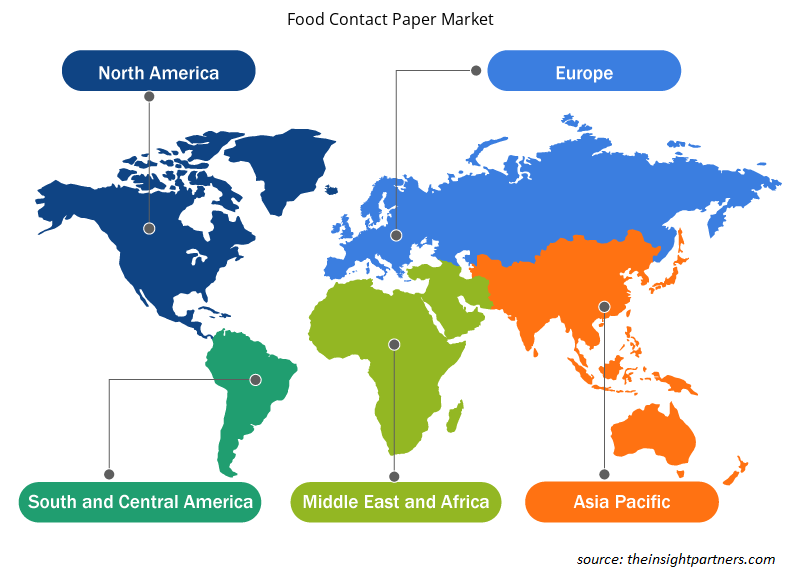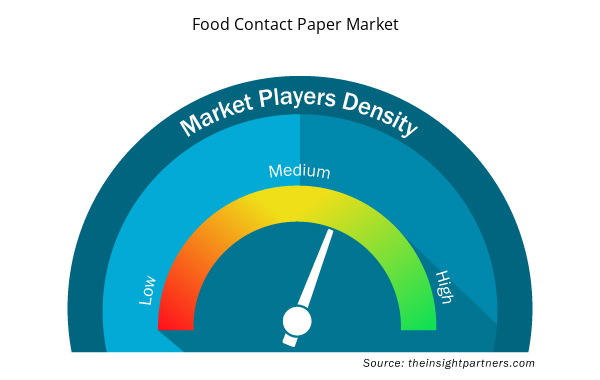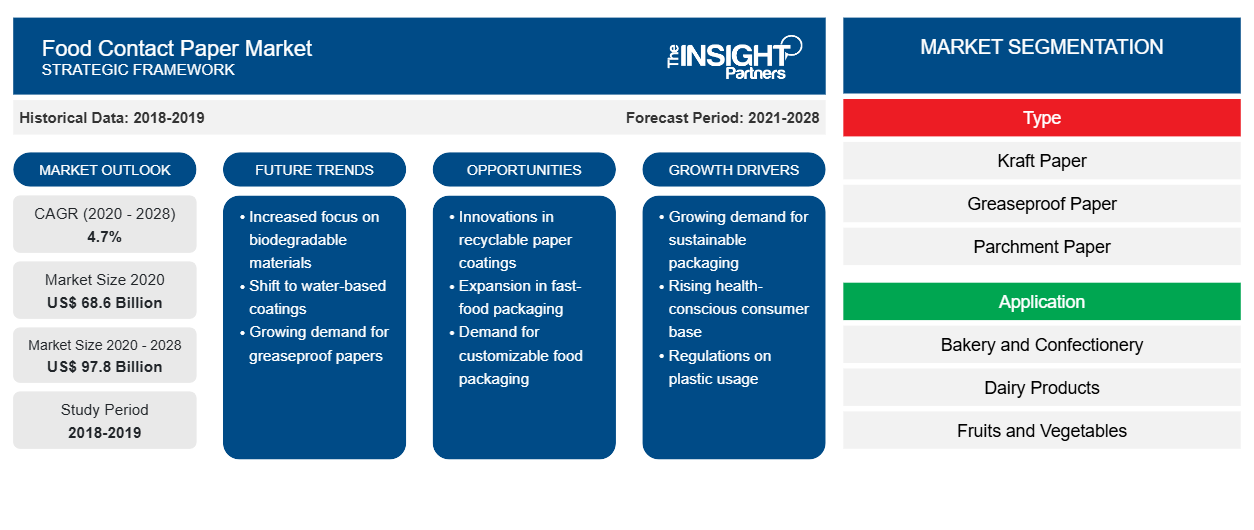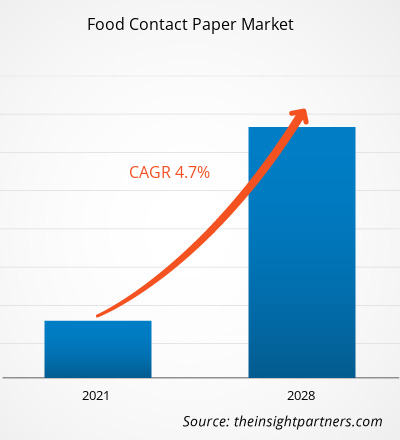El mercado de papel en contacto con alimentos se valoró en 68.600 millones de dólares en 2020 y se proyecta que alcance los 97.800 millones de dólares en 2028; se espera que crezca a una CAGR del 4,7% entre 2021 y 2028.
Los papeles en contacto con alimentos se utilizan como material de envasado primario para diversos productos alimenticios, como alimentos horneados, dulces, carnes, bocadillos y productos de molienda de cereales. Los papeles son alternativas sostenibles a muchos otros materiales de envasado de alimentos, como el plástico y el vidrio. Las crecientes iniciativas de las empresas para reducir su huella de carbono están influyendo en la adopción de papel en contacto con alimentos en todo el mundo. El aumento de la demanda de envases de alimentos sostenibles y ecológicos también ha aumentado la demanda de envases de papel para alimentos.
En 2020, Asia Pacífico dominó el mercado mundial de papel para contacto con alimentos y se espera que continúe su dominio durante el período de pronóstico. Se espera que la creciente industria de servicios de alimentos en los países asiáticos, la creciente conciencia sobre el medio ambiente y el aumento de las iniciativas gubernamentales para prohibir los envases de plástico en varios países asiáticos aceleren la demanda de soluciones de embalaje ecológicas y sostenibles, lo que impulsaría el crecimiento del mercado de papel para contacto con alimentos en Asia Pacífico.
Personalice este informe según sus necesidades
Obtendrá personalización en cualquier informe, sin cargo, incluidas partes de este informe o análisis a nivel de país, paquete de datos de Excel, así como también grandes ofertas y descuentos para empresas emergentes y universidades.
- Obtenga las principales tendencias clave del mercado de este informe.Esta muestra GRATUITA incluirá análisis de datos, desde tendencias del mercado hasta estimaciones y pronósticos.
Muchas industrias, como la industria química y de materiales, se enfrentaron a desafíos sin precedentes debido a la pandemia de COVID-19. Debido a la escasez de materia prima y mano de obra, el cierre de fábricas y otras dificultades operativas bajo los protocolos de seguridad de COVID-19, los fabricantes de productos de embalaje enfrentaron una contracción en las ventas durante los meses iniciales de la pandemia. Además, el cambio en el estilo de vida de los consumidores y sus cambiantes patrones de alimentación han reducido el consumo de alimentos listos para usar y de exterior debido a la propagación del virus, lo que ha afectado negativamente a la demanda de papeles de contacto con alimentos. Sin embargo, como varios países están levantando el bloqueo con las medidas de precaución adecuadas, es probable que la demanda de papeles de contacto con alimentos vuelva a encarrilarse. A medida que se impuso el bloqueo en varios países, el sector del comercio electrónico fue testigo de una demanda significativa de varios productos, como alimentos envasados y comestibles, incluidas verduras y frutas frescas, debido al cierre de las tiendas físicas, lo que impulsó la utilización de papeles de contacto con alimentos.
Perspectivas del mercado
Demanda en aumento de soluciones de embalaje reciclables y biodegradables
Los envases biodegradables y reciclables han sido una alternativa atractiva a las opciones de envases de un solo uso tanto para los consumidores como para los fabricantes. Los envases de servicios alimentarios generan una cantidad significativa de residuos en los vertederos de los EE. UU. Según un informe publicado por la Agencia de Protección Ambiental de los Estados Unidos, los residuos y envases de alimentos representan la mayoría de los materiales que se vierten en los vertederos de los EE. UU. Dado que los envases de papel son biodegradables, se prefieren a los envases reciclables. El uso de envases de alimentos reciclados aumenta las posibilidades de contaminación, lo que puede afectar potencialmente al medio ambiente y la salud humana. Las crecientes iniciativas de los gobiernos de todo el mundo sobre el uso de bolsas de plástico de un solo uso están impulsando la demanda de soluciones de envasado que sean reciclables y, al mismo tiempo, sostenibles, lo que genera una mayor demanda de papeles en contacto con alimentos.
Tipo de información
Según el tipo, el mercado de papel en contacto con alimentos se segmenta enPapel kraft, papel resistente a la grasa, papel pergamino y otros. El segmento de papel kraft tuvo la mayor participación de mercado en 2020. Los papeles kraft naturales tienen fibras vírgenes puras, lo que los convierte en una solución ideal para el envasado en contacto con alimentos. El papel se utiliza cada vez más para fabricar diversos productos de papel en contacto con alimentos, como bolsas de papel, sacos de papel, papel de regalo y platos de papel. El papel kraft natural también se utiliza cada vez más para fabricar bolsas de supermercado para frutas y verduras frescas debido a su alta resistencia.
Mondi; Westrock Company; Georgia-Pacific LLC; Twin River Paper Company; UPM; Ahlstrom-Munksjö; GM Packaging (UK) Ltd; Superiorpaper Pty Ltd. TopCare; y KRPA Holding CZ, entre otros, se encuentran entre los actores clave que operan en el mercado del papel para contacto con alimentos. Los principales actores del mercado están adoptando estrategias como fusiones y adquisiciones y lanzamientos de productos para expandir su presencia geográfica y su base de consumidores.
Informe Destacado
- Tendencias progresivas en la industria del papel en contacto con alimentos que ayudarán a los actores a desarrollar estrategias efectivas a largo plazo
- Estrategias de crecimiento empresarial adoptadas por las empresas para asegurar el crecimiento en los mercados desarrollados y en desarrollo
- Análisis cuantitativo del mercado mundial de papel en contacto con alimentos de 2019 a 2028
- Estimación de la demanda de papel en contacto con alimentos en diversas industrias
- Análisis de Porter para ilustrar la eficacia de los compradores y proveedores que operan en la industria para predecir el crecimiento del mercado
- Desarrollos recientes para comprender el escenario competitivo del mercado y la demanda de papel en contacto con alimentos
- Tendencias y perspectivas del mercado junto con los factores que impulsan y restringen el crecimiento del mercado del papel en contacto con alimentos
- Comprensión de las estrategias que sustentan el interés comercial en relación con el crecimiento del mercado mundial de papel en contacto con alimentos, lo que ayuda en el proceso de toma de decisiones.
- Tamaño del mercado de vidrio flotado en varios nodos del mercado
- Descripción detallada y segmentación del mercado mundial de papel en contacto con alimentos, así como su dinámica industrial
- Tamaño del mercado de papel de contacto con alimentos en varias regiones con oportunidades de crecimiento prometedoras
Perspectivas regionales del mercado de papel en contacto con alimentos
Los analistas de Insight Partners explicaron en detalle las tendencias regionales y los factores que influyen en el mercado de papel en contacto con alimentos durante el período de pronóstico. Esta sección también analiza los segmentos y la geografía del mercado de papel en contacto con alimentos en América del Norte, Europa, Asia Pacífico, Oriente Medio y África, y América del Sur y Central.

- Obtenga datos regionales específicos para el mercado de papel en contacto con alimentos
Alcance del informe de mercado de papel para contacto con alimentos
| Atributo del informe | Detalles |
|---|---|
| Tamaño del mercado en 2020 | US$ 68,6 mil millones |
| Tamaño del mercado en 2028 | US$ 97.8 mil millones |
| Tasa de crecimiento anual compuesta (CAGR) global (2020-2028) | 4,7% |
| Datos históricos | 2018-2019 |
| Período de pronóstico | 2021-2028 |
| Segmentos cubiertos | Por tipo
|
| Regiones y países cubiertos | América del norte
|
| Líderes del mercado y perfiles de empresas clave |
|
Densidad de actores del mercado de papel en contacto con alimentos: comprensión de su impacto en la dinámica empresarial
El mercado de papel para contacto con alimentos está creciendo rápidamente, impulsado por la creciente demanda de los usuarios finales debido a factores como la evolución de las preferencias de los consumidores, los avances tecnológicos y una mayor conciencia de los beneficios del producto. A medida que aumenta la demanda, las empresas amplían sus ofertas, innovan para satisfacer las necesidades de los consumidores y aprovechan las tendencias emergentes, lo que impulsa aún más el crecimiento del mercado.
La densidad de actores del mercado se refiere a la distribución de las empresas o firmas que operan dentro de un mercado o industria en particular. Indica cuántos competidores (actores del mercado) están presentes en un espacio de mercado determinado en relación con su tamaño o valor total de mercado.
Las principales empresas que operan en el mercado de papel en contacto con alimentos son:
- Mundo
- Compañía Westrock
- Georgia-Pacific LLC
- Compañía de papel Twin River
- UPM
Descargo de responsabilidad : Las empresas enumeradas anteriormente no están clasificadas en ningún orden particular.

- Obtenga una descripción general de los principales actores clave del mercado de papel en contacto con alimentos
Mercado de papel para contacto con alimentos, por tipo
- Papel Kraft
- Papel a prueba de grasa
- Papel pergamino
- Otros
Mercado de papel para contacto con alimentos, por aplicación
- Panadería y Confitería
- Productos lácteos
- Frutas y verduras
- Carne, pescado y aves de corral
- Otros
Perfiles de empresas
- Mundo
- Compañía Westrock
- Georgia-Pacific LLC
- Compañía de papel Twin River
- UPM
- Ahlström-Munksjö
- GM Packaging (Reino Unido) Ltd.
- Superiorpaper Pty Ltd
- Cuidado superior
- KRPA Holding CZ, como
- Análisis histórico (2 años), año base, pronóstico (7 años) con CAGR
- Análisis PEST y FODA
- Tamaño del mercado Valor/volumen: global, regional, nacional
- Industria y panorama competitivo
- Conjunto de datos de Excel


- Energy Recovery Ventilator Market
- Personality Assessment Solution Market
- Mesotherapy Market
- Water Pipeline Leak Detection System Market
- Excimer & Femtosecond Ophthalmic Lasers Market
- Electronic Data Interchange Market
- Europe Industrial Chillers Market
- Semiconductor Metrology and Inspection Market
- Nitrogenous Fertilizer Market
- Virtual Production Market

Report Coverage
Revenue forecast, Company Analysis, Industry landscape, Growth factors, and Trends

Segment Covered
This text is related
to segments covered.

Regional Scope
North America, Europe, Asia Pacific, Middle East & Africa, South & Central America

Country Scope
This text is related
to country scope.
Preguntas frecuentes
Based on application, the global food contact paper market is segmented into bakery and confectionery, dairy products, fruits and vegetables, meat fish and poultry, and others. In 2020, the bakery and confectionery segment accounted for a significant revenue share. The food contact paper is being increasingly used in the bakery and confectionery sector which includes the usage of parchment paper in baking as it is heat-resistant and provides a non-stick surface to bake on. The common use of parchment paper is to eliminate the need for grease sheet pans and also allows a very rapid turnaround of batches of baked goods with minimal clean-up. Greaseproof paper is also an ideal solution for bakery items as it is able to withstand a wide range of environments, from hot oven to deep freezer & humidity.
On the basis of type, the greaseproof paper segment held the fastest CAGR in the food contact paper market for the forecast period. The paper is used for wrapping food items such as sandwiches, cheese, desserts, baked goods, and cold meats. The greaseproof paper will help in providing a grease-free method for transporting and handling oily foods. These papers are also recyclable as well as printable. The greaseproof paper is permeable to air and moisture, which makes it possible for the food inside the paper to breathe and steam and exhale excess moisture.
The fruit and vegetable segment is expected to grow at the fastest rate during the forecast period. There has been an increase use of kraft paper in various food contact paper packaging solutions for fruits and vegetables. It is being used as a vegetable box which is used for packaging and shipping of the vegetables and fruits as well as is used to produce embossed paper cushion pads for the packaging of vegetables and fresh fruit. Along with this, wax paper is also used for storing fruits and vegetables as the moisture retention capabilities of wax paper will keep the fruits and vegetables fresh for a longer period of time and will slow down their ripening and spoilage rate.
Kraft paper is basically a paper or paperboard which is being produced from the chemical pulp through kraft papers. The natural kraft papers have pure virgin fibers which makes it an ideal food contact packaging solution. Kraft paper is being increasingly used for manufacturing various food contact papers including paper bags, paper sacks, wrapping paper, and paper plates. Natural kraft paper is also being increasingly used as a grocery bag for fresh fruits and vegetables which is due to its high strength.
The major key players operating in the global food contact paper market include Mondi; Westrock Company; Georgia-Pacific LLC; Twin River Paper Company; UPM; Ahlstrom-Munksjö; GM Packaging (UK) Ltd; Superiorpaper Pty Ltd. TopCare; and KRPA Holding CZ, a.s and SK Hynix Inc.
The Asia Pacific dominated the global market. The region is expected to continue its dominance during the forecast period. The growing market penetration of the foodservice industry in recent years in the Asian countries is estimated to accelerate the food contact paper market growth in this region during the forecast period. Along with this, an increase in awareness about the environment is expected to result in increased demand for greener packaging solutions. Various initiatives taken by the government to ban plastic packaging in several Asian countries are also expected to accelerate the demand for eco-friendly and sustainable packaging solutions, which will increase the demand for food contact paper in the Asia Pacific. Along with this, the increasing presence of domestic and international players in the market has led to an increased focus of product quality and innovation, which will provide growth opportunities for the food contact paper market.
Trends and growth analysis reports related to Chemicals and Materials : READ MORE..
The List of Companies - Food Contact Paper Market
- Mondi
- Westrock Company
- Georgia-Pacific LLC
- Twin River Paper Company
- UPM
- Ahlstrom-Munksjö
- GM Packaging (UK) Ltd
- Superiorpaper Pty Ltd
- TopCare
- KRPA Holding CZ, a.s.
The Insight Partners performs research in 4 major stages: Data Collection & Secondary Research, Primary Research, Data Analysis and Data Triangulation & Final Review.
- Data Collection and Secondary Research:
As a market research and consulting firm operating from a decade, we have published and advised several client across the globe. First step for any study will start with an assessment of currently available data and insights from existing reports. Further, historical and current market information is collected from Investor Presentations, Annual Reports, SEC Filings, etc., and other information related to company’s performance and market positioning are gathered from Paid Databases (Factiva, Hoovers, and Reuters) and various other publications available in public domain.
Several associations trade associates, technical forums, institutes, societies and organization are accessed to gain technical as well as market related insights through their publications such as research papers, blogs and press releases related to the studies are referred to get cues about the market. Further, white papers, journals, magazines, and other news articles published in last 3 years are scrutinized and analyzed to understand the current market trends.
- Primary Research:
The primarily interview analysis comprise of data obtained from industry participants interview and answers to survey questions gathered by in-house primary team.
For primary research, interviews are conducted with industry experts/CEOs/Marketing Managers/VPs/Subject Matter Experts from both demand and supply side to get a 360-degree view of the market. The primary team conducts several interviews based on the complexity of the markets to understand the various market trends and dynamics which makes research more credible and precise.
A typical research interview fulfils the following functions:
- Provides first-hand information on the market size, market trends, growth trends, competitive landscape, and outlook
- Validates and strengthens in-house secondary research findings
- Develops the analysis team’s expertise and market understanding
Primary research involves email interactions and telephone interviews for each market, category, segment, and sub-segment across geographies. The participants who typically take part in such a process include, but are not limited to:
- Industry participants: VPs, business development managers, market intelligence managers and national sales managers
- Outside experts: Valuation experts, research analysts and key opinion leaders specializing in the electronics and semiconductor industry.
Below is the breakup of our primary respondents by company, designation, and region:

Once we receive the confirmation from primary research sources or primary respondents, we finalize the base year market estimation and forecast the data as per the macroeconomic and microeconomic factors assessed during data collection.
- Data Analysis:
Once data is validated through both secondary as well as primary respondents, we finalize the market estimations by hypothesis formulation and factor analysis at regional and country level.
- Macro-Economic Factor Analysis:
We analyse macroeconomic indicators such the gross domestic product (GDP), increase in the demand for goods and services across industries, technological advancement, regional economic growth, governmental policies, the influence of COVID-19, PEST analysis, and other aspects. This analysis aids in setting benchmarks for various nations/regions and approximating market splits. Additionally, the general trend of the aforementioned components aid in determining the market's development possibilities.
- Country Level Data:
Various factors that are especially aligned to the country are taken into account to determine the market size for a certain area and country, including the presence of vendors, such as headquarters and offices, the country's GDP, demand patterns, and industry growth. To comprehend the market dynamics for the nation, a number of growth variables, inhibitors, application areas, and current market trends are researched. The aforementioned elements aid in determining the country's overall market's growth potential.
- Company Profile:
The “Table of Contents” is formulated by listing and analyzing more than 25 - 30 companies operating in the market ecosystem across geographies. However, we profile only 10 companies as a standard practice in our syndicate reports. These 10 companies comprise leading, emerging, and regional players. Nonetheless, our analysis is not restricted to the 10 listed companies, we also analyze other companies present in the market to develop a holistic view and understand the prevailing trends. The “Company Profiles” section in the report covers key facts, business description, products & services, financial information, SWOT analysis, and key developments. The financial information presented is extracted from the annual reports and official documents of the publicly listed companies. Upon collecting the information for the sections of respective companies, we verify them via various primary sources and then compile the data in respective company profiles. The company level information helps us in deriving the base number as well as in forecasting the market size.
- Developing Base Number:
Aggregation of sales statistics (2020-2022) and macro-economic factor, and other secondary and primary research insights are utilized to arrive at base number and related market shares for 2022. The data gaps are identified in this step and relevant market data is analyzed, collected from paid primary interviews or databases. On finalizing the base year market size, forecasts are developed on the basis of macro-economic, industry and market growth factors and company level analysis.
- Data Triangulation and Final Review:
The market findings and base year market size calculations are validated from supply as well as demand side. Demand side validations are based on macro-economic factor analysis and benchmarks for respective regions and countries. In case of supply side validations, revenues of major companies are estimated (in case not available) based on industry benchmark, approximate number of employees, product portfolio, and primary interviews revenues are gathered. Further revenue from target product/service segment is assessed to avoid overshooting of market statistics. In case of heavy deviations between supply and demand side values, all thes steps are repeated to achieve synchronization.
We follow an iterative model, wherein we share our research findings with Subject Matter Experts (SME’s) and Key Opinion Leaders (KOLs) until consensus view of the market is not formulated – this model negates any drastic deviation in the opinions of experts. Only validated and universally acceptable research findings are quoted in our reports.
We have important check points that we use to validate our research findings – which we call – data triangulation, where we validate the information, we generate from secondary sources with primary interviews and then we re-validate with our internal data bases and Subject matter experts. This comprehensive model enables us to deliver high quality, reliable data in shortest possible time.


 Obtenga una muestra gratuita de este informe
Obtenga una muestra gratuita de este informe